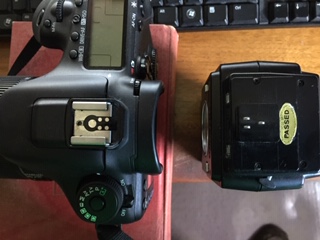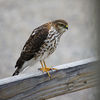Old Flash - New Camera
Oct 10, 2018 15:49:10 #
I have a Canon SpeedLite 199A flash left over from my film days. I used it with Canon A-1. I now have a Canon 7DMkII. The flash will lock onto the hotshoe of the 7DMkII but I'm afraid of trying it for fear of frying the 7DMkII's electronics. The camera has a large contact and four small contacts. The flash has a center contact and two others. They will probably mate with the large and two of the small contacts on the camera. Does anyone know if this flash will work without damaging the camera? I will include a photo of the mating surfaces of the devices. I looked on the Canon web site but didn't find anywhere I could ask a question like this. Thanks in advance for your help.

Oct 10, 2018 15:56:28 #
larryepage
Loc: North Texas area
Most older flashes used a very high trigger voltage...usually around 150 volts. Some modern camera bodies will not handle these high voltages. Many professional bodies can handle the high voltage, but not all. It is critically important that you verify compatibility, by learning the 7D's capability from the documentation and by either measuring or otherwise learning the flash's trigger voltage. The risk of damage makes it not worth just plugging and trying.
And be prepared that the extended functions of the older flash may not work as you expect. But if the trigger voltage is compatible, you should be able to use it in manual or in the flash's internal automatic mode.
And be prepared that the extended functions of the older flash may not work as you expect. But if the trigger voltage is compatible, you should be able to use it in manual or in the flash's internal automatic mode.
Oct 10, 2018 16:05:18 #
larryepage wrote:
Most older flashes used a very high trigger voltag... (show quote)
Thanks for the info. I won't even take the chance, I'll just leave it in the old camera bag along with the other old equipment. Thanks again.
Oct 10, 2018 16:06:09 #
Refer to pages 259-260 of your 7DII manual. I have this same flash, but for my AE-1 and F1 bodies. It's not listed as a Canon compatible Speedlite and I'd be hesitant to test whether it will work with an EOS body given all the known compatible options that do not present a risk to the camera. If you should take the risk in testing, expect the flash to fire only at maximum power where you'll have to adjust the camera's exposure to account for the power of the light created by the flash.
This post from the 'Canon Community' points to the flash working on an EOS T2i. The same should apply to your 7DII with the caveat above and discussed in the several responses at:
https://community.usa.canon.com/t5/Speedlites/Can-I-use-my-Canon-Speedlight-199A-with-my-Canon-T2i/td-p/62273
This post from the 'Canon Community' points to the flash working on an EOS T2i. The same should apply to your 7DII with the caveat above and discussed in the several responses at:
https://community.usa.canon.com/t5/Speedlites/Can-I-use-my-Canon-Speedlight-199A-with-my-Canon-T2i/td-p/62273
Oct 10, 2018 16:11:19 #
larryepage wrote:
This article will help. You need to reduce the voltage not to fry your electronics on the camera.Most older flashes used a very high trigger voltag... (show quote)
https://www.shutterbug.com/content/using-older-electronic-flash-digital-cameras-what-works—what-doesn’t
Consider this flash.
https://www.bhphotovideo.com/c/product/1311157-REG/yongnuo_yn600ex_rt_ii_speedlite_for.html
Oct 10, 2018 16:12:22 #
CHG_CANON wrote:
Refer to pages 259-260 of your 7DII manual. I have... (show quote)
If I decide on a flash, I'll make sure to get an EX model. Thanks.
Oct 10, 2018 16:15:22 #
TV714 wrote:
I have a Canon SpeedLite 199A flash left over from... (show quote)
Welcome to the forum.
The bottom line old film flash units have a high voltage that can cook/fry/ruin your digital camera.
So you have 2 choices. Buy a compatible flash for your camera or use your old flash with some limitation with a voltage reducer.
https://www.shutterbug.com/content/using-older-electronic-flash-digital-cameras-what-works—what-doesn’t
Oct 10, 2018 16:18:44 #
TV714 wrote:
If I decide on a flash, I'll make sure to get an EX model. Thanks.
I use the 580EX II. They're slightly more advanced than the original 580EX. Their prices have been dropping for used versions as they grow older relative to the current 600EX II. Either version of the 580EX is an excellent value so pick one / a few based on how much you want to spend.
Oct 10, 2018 20:16:57 #
I have 2 of the 199A's but I have no Canon DSLR. Of course they work fine with my Canon A1 and AE1 but they also work fine with my Nikon DSLR's. The 199A has 3 auto range and 1 manual range which is full power. The 3 auto ranges are f/2.8, f/5.6 and f/11 for ISO 100. With higher ISO simply shift the aperture toward smaller.
Oct 10, 2018 20:29:28 #
RWR
Loc: La Mesa, CA
TV714 wrote:
I have a Canon SpeedLite 199A flash left over from... (show quote)
Very few flashes of any brand ever made have dangerously high trigger voltages. The highest voltage I could find for Canon, the Canolite D, is only 185 volts. Nikons can handle up to 250 volts, I should think that Canons would be as well built. The trigger voltage of your 199A is a mere 6 volts, enjoy it!
The trigger voltage for most older flashes is listed here:
http://dpanswers.com/roztr/volt_finder.php
Oct 10, 2018 21:06:06 #
Flash trigger voltage is less than 6 volts (reference available); use it without fear.
Oct 10, 2018 21:15:41 #
RWR wrote:
Very few flashes of any brand ever made have dangerously high trigger voltages. The highest voltage I could find for Canon, the Canolite D, is only 185 volts. Nikons can handle up to 250 volts, I should think that Canons would be as well built. The trigger voltage of your 199A is a mere 6 volts, enjoy it!
The trigger voltage for most older flashes is listed here:
http://dpanswers.com/roztr/volt_finder.php
The trigger voltage for most older flashes is listed here:
http://dpanswers.com/roztr/volt_finder.php
Here's another link that shows how to test the voltage yourself. I don't connect my old flash units directly to my cameras. I use wireless triggers, but still want to know the voltage.
http://dpanswers.com/content/genrc_flash_measuretv.php
Oct 10, 2018 21:43:33 #
RWR
Loc: La Mesa, CA
The Watcher wrote:
Here's another link that shows how to test the voltage yourself. I don't connect my old flash units directly to my cameras. I use wireless triggers, but still want to know the voltage.
http://dpanswers.com/content/genrc_flash_measuretv.php
http://dpanswers.com/content/genrc_flash_measuretv.php
Good point. If there’s any doubt, it pays to check the voltage.
Oct 10, 2018 23:45:32 #
RWR wrote:
Good point. If there’s any doubt, it pays to check the voltage.
I use a lot of old flashes. So I label all my flash units with (1) the center contact voltage
and (2) the guide number (in feet) at full-power manual mode.
A label maker does the job: e.g.: 200V 120FT. Anything over 5V (= TTL Vcc)
gets labeled in orange; anything over 24V in red (that's a little finicky, I know, but flash
units often get used in low light).

Also, be aware that all flash units use a a high voltage (150-300 V) internally
and charge of big capactor at that voltage. It definitely can kill (and is much more
dangerous than the same AC voltage, because you won't necessarily jerk away).
List of flash unit voltages: http://www.botzilla.com/photo/strobeVolts.html
Oct 11, 2018 07:17:08 #
If you want to reply, then register here. Registration is free and your account is created instantly, so you can post right away.





